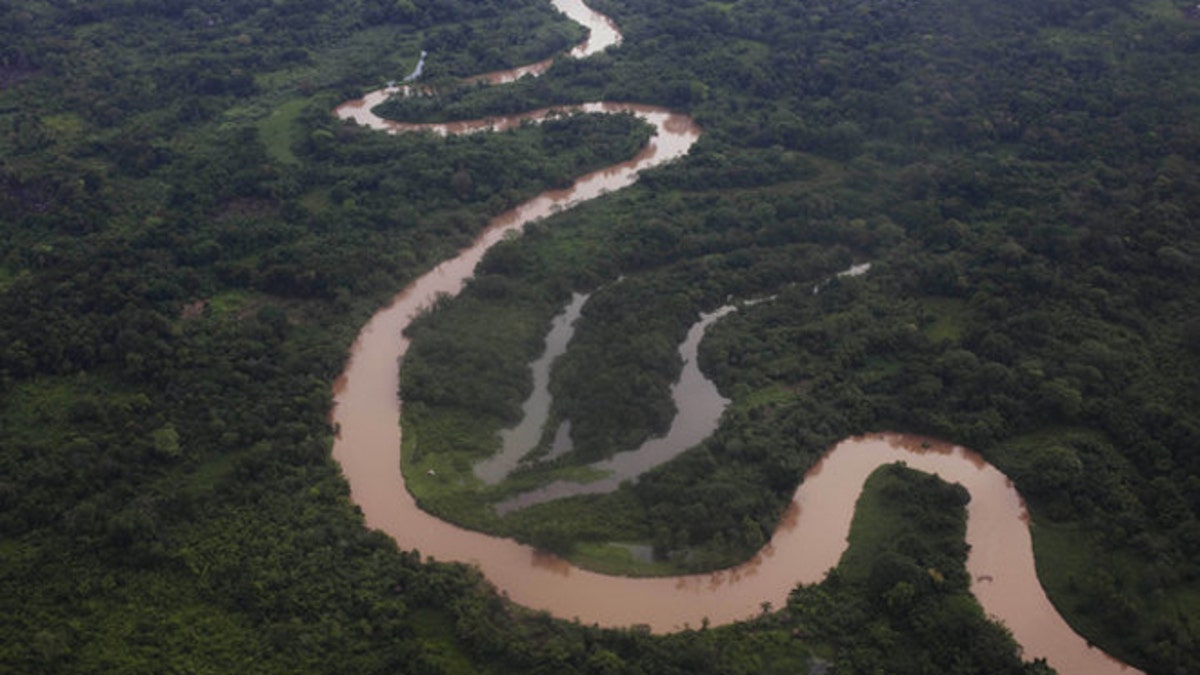
An aerial view of Honduras' Mosquitia region. (AP)
Known as Central America’s Little Amazon, Honduras’ Mosquitia region is a vast, lightly inhabited 32,000-square-mile region of tropical rainforest, lagoons, mangrove swamps, rivers, remote beaches and a diverse grouping of flora and fauna including the deadly jumping viper.
Underneath its thick and humid canopy, archeologists also believe that the Mosquitia contains the ruins of the famed Ciudad Blanca.
Using a form of light detection and ranging equipment known as lider, a group of archaeologists and filmmakers including Steven Elkins and Bill Benenson announced that they have possibly discovered the ruins of the centuries-old lost city. In layman’s terms, the scientists flew a small plane over the dense stretch of jungle, shooting lasers at the topography to map out the land below the canopy, where they purportedly discovered a network of plazas and pyramids, hidden for hundreds of years.
“Some people believe it’s a bunch of hooey. Others believe that where there’s smoke there’s fire,” Elkins said, according to the UK newspaper The Independent. “I became captivated by it, and I decided to wait until technology advanced to produce a better way to find it than walking aimlessly through the jungle. Many years later, that opportunity presented itself.”
The mystery of Ciudad Blanca (or The White City in English) has tempted explorers and treasure hunters as far back as 1526, when Spanish conquistador Hernán Cortés sent a letter to Spanish emperor Charles V after hearing "reliable" rumors of an area in Honduras that “will exceed Mexico in riches, and equal it in the largeness of its towns and villages.” Cortés never found the city, but rumors of its existence persisted, especially following the discovery of the Maya city of Copán, in western Honduras, by American John Lloyd Stephens in 1839.
Another American, Theodore Morde claimed to have found what he called the Lost City of the Monkey God – named for the allegation that local indigenous people worshipped huge ape sculptures – in 1939. Morde went off a tip from Charles Lindbergh, the first solo aviator to cross the Atlantic, who apparently saw “an amazing ancient metropolis” when flying over the jungle.
Morde, however, was killed in a car accident before revealing the location of the city he purportedly found.
The jungle's remote location and the dangers that accompany a journey into the heart of darkness – poisonous snakes, disease, oppressive heat, dense foliage - has kept many explorers at bay and thwarted other attempts.
“It’s mountainous,” Chris Begley, an archeologist and expert on Honduras, told The New Yorker. “There’s white water. There are jumping vipers, coral snakes, fer-de-lance, stinging plants, and biting insects. And then there are the illnesses—malaria, dengue fever, leishmaniasis, Chagas’.”
The airplane and other modern technological advancement have made the search for the lost city a little easier, and while a group in 1998 claims to have discovered it using Synthetic aperture radar (SAR), Elkins and Benenson appear to have the best claims to discovering La Ciudad Blanca.
Christopher Fisher and Stephen Leisz of Colorado State University, the project's main archeologists, claim that city was home to a sophisticated Mesoamerican society that had paved streets, parks, pyramids and an advanced irrigation system that dates back to around 500 A.D.
The city’s exact location has remained a secret as the Honduran government and archeologists worry about possible looting and plan to make a full ground expedition this fall.
“It opens the door into a lost world,” Fisher said. “Archaeology is on the cusp of a technological transformation. It’s going to transform our understanding of the Americas.”
Follow us on twitter.com/foxnewslatino
Like us at facebook.com/foxnewslatino
